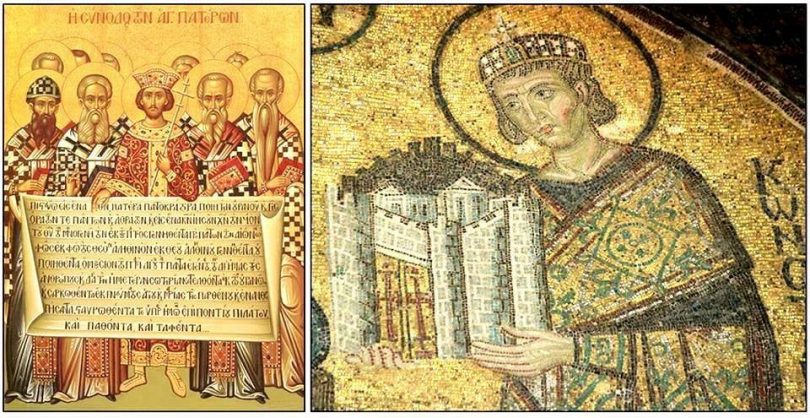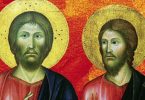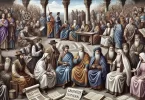On this day, on February 27, 272, the glorious first Christian emperor and founder of the reigning Constantinople, Constantine I the Great was born.
In short…
Flavios Valerios Aurelios Constantine, one of the most controversial personalities in history, has certainly been a great founder. He founded the new capital of the Roman state, a new dynasty, but also a new religion, which was meant to monopolize the adoration of Late Antiquity. Although in the early stages of his career and his life he was involved in civil wars and domestic disputes that ended in bloodbaths, he was then repented and canonized by the Christian Church, which he seems to have actively protected, bringing it out of illegality. His biographer, Eusebius of Caesarea, made sure to ease the gloomy spots and highlight the bright elements of his personality and History, who loves explosive personalities, gave him the last name Mega.
And with more…
Roman emperor (324-337). He was named the Great for his complex work, which directly or indirectly influenced world history. The Orthodox Church proclaimed him Saint and Isapostol because he always supported Christianity. His memory is celebrated with that of Saint Helen’s mother on May 21 The Roman Catholic Church doesn’t have him in the village of its Saints because his historical investigation charges the order for the murder of Krispos’s son and his second wife Favstas (Krispos and Fausta must have had an erotic relationship, according to the latest historical data) ..
Flavius Valerius Aurelius Constantinus was born on February 27, 272 in Naissos, Upper Moesia (today Nis Serbia) and was the son of Roman officer Constantius Chloros and Eleni’s wife or concubine. He learned the circular letters near his father and from a young age he joined the Roman army, where he distinguished himself for his administrative skills and overall personality. Promoting his father to the highest levels of the empire also helped his own development in the Rome military hierarchy.
In 305 he followed his father in his campaign in Great Britain and after his death (July 7, 306) he was proclaimed by his troops as successor with August title in Evorako (today York). During a time of great tensions in the empire because of the multitude, Constantine wanted to become dominant first in the Western section and then in the Eastern. That’s why Maxentius had to prevail first August of the West.
Constantine and Maxentius armies met in October 312 on the outskirts of Rome, near Mulvia Tiber Bridge. On the eve of the battle, on October 27, Constantine saw his famous vision, according to which rays of light formed a cross cluster in the sky with the phrase ′′ Nika “. This incident, which he considered as ′′ divine inspiration “, combined with his military abilities, led him the next day (October 28th) to a proud victory over Maxentius, which made him dominant of the West.
Although he did not have the slightest relationship with Christianity, he penetrated the dynamics of this religion and decided to adopt it and be ok in his politics. In 313, he signed with his ally in East Licinio the ′′ Mediolan Decree ′′, enshrining the principle of indecency and religious freedom in his territory. The ground had been prepared since 311 by the decree of Emperor Galerius, which ceased persecution against Christians.
Constantine’s ambitions did not stop with his dominance in the West. He wanted to dominate the entire empire and therefore he quickly collided with his ally in the East and son-in-law Licinio (Licinius was the wife of Constantine’s sister, Constantine). Constantine dominated a series of battles and battles and in 324 became dominant over the entire empire.
After his dominance, Constantine’s main concern was the rise of the faltering empire. With a series of reforms he carried out, he restored the unity of imperial power and restricted centrally trends by abolishing August and Caesar’s offices, while significantly restricting Senate powers. In the economic field, he cut a new currency, the solo and made massive gold markets, which not only stabilized it, but made it the most stable currency in the international market until the 11th century. In the administrative field, the transfer of the capital from Rome to New Rome or Istanbul was crucial to the radical renewal of the empire that Constantine sought. The inauguration of the new capital took place with great brilliance on May 11, 330.
Constantine’s favor to the church was expressed with his constant interest in restoring her inner unity, broken into by the cult of Martianism. This is why he convened the First Ecumenical Summit in 325 in Nice, which determined the doctrine of Christianity (′′ I believe ′′). Shortly before his death on May 22, 337, Constantine was baptized Christian.
The Great Constantine had married twice: In 303 Minervine, with which he had a son, Krispos and in 307, Favsta, with whom he had five children, Constantinos, Constantine, Constantine and Eleni. In 326 Constantine ordered the murder of his eldest son Krispos and his second wife Fausta because, during the prevailing version, they suspected they had a love affair. For this reason, the Roman Catholic Church does not recognize the Great Constantine as Saint.
In the photo:
Left: Picture presenting the First Ecumenical Summit of Nice. Roman Emperor Constantine I is in the center surrounded by Church Fathers. The role contains the first half of the Faithful Nikea-Istanbul symbol.
Right: Constantine I offers Istanbul to Virgin Mary. Mosaic detail located in Agia Sophia.
From ‘Αγιά Σοφιά / Hagia Sophia’
Comments:
Χορωδία Ειρμός
Exactly! Because his canonization took place almost 700 years before Schisma! So there was no Eastern and Western Church then, it was single. As for the name, it is clear: How many emperors had it (11), 2 modern kings of the Greeks, while also one of the most popular names among the Greeks.
Θανάσης Κουκόπουλοςπ.
The West’s attitude towards the Great Constantine is a bit misunderstood. And this is due to the ′′ Enlightenment ′′ movement. Just because Westerners did not give and give the name Constantine says nothing for themselves. In the 8th century AD, the Westerners presented a fake text known as Donatio Constantini. Based on this, the Great Constantine was supposed to grant the power of the western part of the empire to the pope (his counterfeit was already pointed out since the Renaissance era). Therefore, according to the narrative of medieval papacy, the Great Constantine was presented as benefactor of the west and not as a man who left her. After all, the collapse of the western part of the empire by German gender attacks is not due to the fact that Constantine ′′ left ′′ the West (already in the years of the successors of M. Constantinople existed in the West as well), but in the political incompetence of the very emperors of the West. Catholics respect M unlimited. Constant (even if they do not officially accept his holiness) and this is evidenced by the following facts: 1. Throughout the Middle Ages no pope called for the destruction of a bronze man of the pagan Roman emperor Markos Aurelio, who was located in a central square in Rome, because it was thought to have depicted M. Constantine 2. Until the time of the Renaissance in the Vatican stood the basilica of St. Peter himself built by M. Constantinos at the beginning of the 4th century AD. Its destruction and the building of today’s famous basilica are due to the need to meet the needs of the new papacy narrative in the context of the formation of Renaissance ideology rather than some disregard for the Saint. 3. At the Vatican Palace there is an entire room dedicated to M. Constantine, decorated with brilliant murals from the life of the first Christian emperor, works of the workshop of the great Rafael painter. 4. At the Vatican Palace again there is an impressive andriad of M. Constantine, work by the great Baroque sculptor Gianlorenzo Bernini. The denigration of the memory of this great Saint is therefore due to ′′ Enlightenment ′′ and not the medieval West. It is good when we express general conclusions to rely on very specific evidence (including archaeology and art history), so as to lead to as balanced views as possible. Bless you.
Νικόλαος Τζογούλας Ρωμανίας
It was a conspiracy… when Constantine realized his wife was behind the punishment and not murder of Krispu punished her too…
Νικόλαος Τζογούλας Ρωμανίας
And that’s why he set up the conspiracy against Krispos who was tried and convicted… he wasn’t murdered… when Constantine understood what had happened he also sent it to trial where she was convicted under the legislation of the era for every traitor…
Ελένη Κατσώρχη
With the transfer of the capital and centre of gravity of the empire to the Greek and evolved East Constantine once again brought Greekism to the foreground of history by handing over the torch of historical continuity. This is how he set the economically and military declining Rome that under the burden of barbaric raids finally collapsed. This is why Westerners reject Constantine as he was correctly said.
Ελένη Κατσώρχη
We should add that those who challenge Constantine’s ethics are based mainly on the testimonies of the historic Zosimos of the 5th century. It is a characteristic that no previous of Zosimos historian refers to the execution of Krispos and Fausta. So we should be careful how we use resources.
Γιώργος
It’s ridiculous that Papal claims they don’t accept the Great Constantine as a saint because he murdered his son well…… Let’s look at their saint a little to see how many murderers they have for ′′ saints ′′ and then talk.







